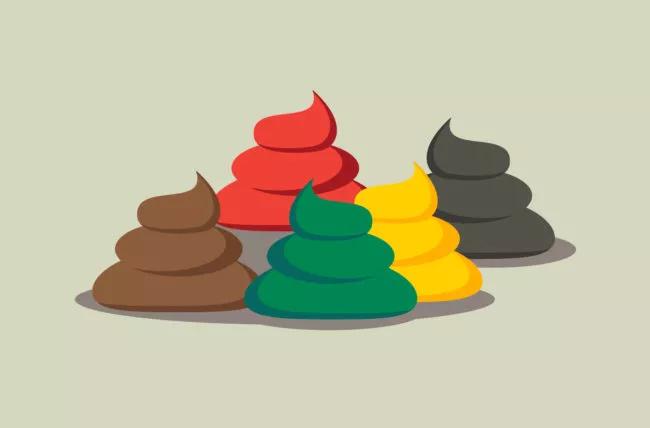Not all rainbows have gold at the end — the ones our bodies produce offer insight into our health

Blood, saliva, phlegm, pus, pee, poop and everybody’s least favorite word: “discharge.” Our bodies generate an awful lot of … for lack of a better word … stuff. And that stuff comes in a wide range of colors. Comparing hues is a quick way to ruin a family meal, but how else are you supposed to know what’s normal?
Advertisement
Cleveland Clinic is a non-profit academic medical center. Advertising on our site helps support our mission. We do not endorse non-Cleveland Clinic products or services. Policy
Never fear! We’ve compiled a cornucopia of colorful articles to satisfy your curiosity. From finding blood where it shouldn’t be to colorful eye crust, we’ll sort through the messages your amazing Technicolor body is trying to send you, moving from top to bottom.
You’ve no doubt heard that the human body is mostly water. It’s true, but water isn’t the only liquid we have sloshing around inside of us. Those other fluids each play a similarly vital role in keeping us alive.
The long list of bodily fluids includes several you hope never to see leave your body, like synovial fluid, cerebrospinal fluid and pericardial fluid.
Then, there are the fluids we expect to see on a regular basis: tears, mucus, saliva, sweat, blood, fecal matter and, for some, breast milk. That’s what we’re focusing on today.

We all wake up to a little wet and/or crusty stuff (AKA rheum) in our eyes from time to time. Usually, that residue is a good sign: It means your eyes cleaned out a mélange of dirt, grime and mucus while you slept. But if the discharge is green or yellow, it could be a sign of infection.

The ancient theory of humorism held that an abundance of phlegm made people reserved, calm and sometimes even apathetic. Turns out, that snot true. Some of us are just more “phlegmboyant” than others.
Advertisement
While it can’t change who you are, the color and consistency of your mucus might help you determine if you’re sick and whether or not to visit a doctor.

Nobody likes vomiting, but we all do it from time to time. Whatever the cause, a toilet-hugging session is always worth taking seriously because of the risk of dehydration. Complications are most likely to occur in babies, children and the elderly. Your gastrointestinal content can look different by the hour, depending on what you ate and why you’re vomiting.
That said, if your vomit looks like anything other than standard-issue “tummy trouble,” it’s time to get medical attention. Pay particular attention to puke that’s black, green, yellow, brown, pink or red. Also, keep an eye on your urine for signs of dehydration (more on that later).

You may not end up breastfeeding, but if you do, it can be … a lot. From worrying about milk supply and storage to the logistics of pumping at work, there’s a ton to think about.
Breast milk comes in a wide variety of colors, and can change based on what you eat and drink and the medications you take. If you’re concerned about the color of your breast milk, speak to your healthcare provider.

If you’re experiencing nipple discharge, it could signal a variety of issues, of which breast cancer, fortunately, is only one. If you’re breastfeeding, you’re likely to experience green — or even black — discharge from time to time. Bloody discharge can be a sign of an issue with your milk duct, but it could also be a sign of breast cancer. Clear discharge is similarly concerning, so be sure to speak to a doctor if you’re seeing those colors.
Remember: Men can also experience nipple discharge. If that happens, you should contact your doctor to rule out breast cancer.

Oh, Aunt Flo. She really loves to keep you on your toes! She’ll do whatever it takes to get your attention, from stopping by unannounced, missing in action, overstaying her welcome or behaving erratically.
It’s normal for your menses to change color, running the gamut from pink to brown. Paired with other symptoms, though, a change in color might be worth following up on. Learn what colors are normal, which aren’t and when it’s time to speak to your Ob/Gyn.

Not sure what to make of blue/green, red or orange pee? What about pee that has no color at all? What about foamy pee? Well, urine luck! We’ll explain the medical reasons behind the nine most common pee colors.
Advertisement

Vaginal discharge is particularly confusing because it’s supposed to be there. It’s also supposed to change throughout your menstrual cycle.
And yet, vaginal discharge can also be a sign of a medical issue. To make matters still more confusing, the same color discharge can have different meanings depending on texture and smell.
From brown and white to gray and yellow, we’ll help you decode the message your vagina is sending about your health.

Whether you care to admit it or not, you probably already know that poop comes in a wide range of colors and consistencies.
More often than not, the color of your bowel movements reflects what you’ve been eating. But that doesn’t mean you shouldn’t take what you see in the toilet seriously. You can learn a lot about your overall health by examining the shape, color and smell of your feces. Just be sure to examine it from a safe distance.
Of course, when it comes to butt byproducts, poop isn’t the only thing you should be paying attention to. You could also see blood on your toilet paper.
When it comes to rectal bleeding, it can be hard to determine why — and from where in your gastrointestinal (GI) tract — you’re bleeding. One way to narrow down the possibilities is to examine the color of the blood.
Advertisement
If you’ve read this far, congratulations: You’re an expert on the kaleidoscope of crud that is the human body! Just be sure to use this newfound knowledge for good, and not for, say, an icebreaker activity at work.
Advertisement
Learn more about our editorial process.
Advertisement

A dermatologist addresses those specks on your skin

Strong vaginal and groin odor is normal for many people — it can be the result of sweat, urine infections and more

As the stalky vegetable breaks down, it leaves behind sulfuric byproducts that can make your pee stink

Most of the time, beeturia is a curiosity, not a concern

Dry skin, eczema, allergies and infections can all cause itchiness — but in some cases, itching may signify a more serious health condition

Your period typically gets darker as the days go on, starting out pink and changing to red, dark red and even brown

Your care team can help you manage the side effects of surgery, chemo and radiation — but you have to let them know what you’re experiencing

Your eyes could be burning because of allergies, elevated salt levels, dry eyes and more

Babies can get congested easily, but you can calm their cough by keeping them hydrated, using nasal drops and running a humidifier

Weight loss may cause loose, sagging skin and muscle loss to your rear

Several conditions, like vitiligo and fungal infection, can cause a loss of pigmentation, leading to white spots or patches on your skin